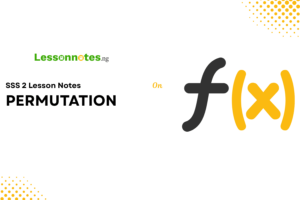Probability SS2 Further Mathematics Lesson Note
Download Lesson NoteTopic: Probability
Probability is a measure of the likelihood that an event will occur in any one trial. Probability can be applied in several areas like insurance, industrial quality control and so on.
It could also be defined as the ratio of the required outcome to the total outcome.
Probability =
No required outcome
Total outcome
NOTE:
- Sample Space: This is the set of all possible outcomes of any random experiment, and it’s denoted by S. The number of outcomes is denoted by n(S).
- Event Space: This is the collection of outcomes of a random experiment. The number is denoted by n(E).
- Outcome: This is the result of an experiment in probability.
The probability that an event is certain to happen is 1, while the probability that an event is certain not to happen is zero (0).
- Range of inequality: 0 <pr (E)<1
Hence; Prob (an event will occur) + prob (an event will not occur) = 1.
EXAMPLE:
From a box containing 2 red,6 white and 5 black balls, a ball is randomly selected. What is the probability that the selected ball is:
(i) black
(ii) white
(iii) not black?
Solution:
Sample space = 2+ 6 + 5 = 13
n(red) = 2, n(white) = 6, n(black) = 5
- Prob. (black) = 5/13
(ii) Prob. (white) = 6/13
iii. Prob. (not black) = 1 – prob. (black) = 1 – 5/13 = 8/13
EQUIPROBABLE SAMPLE SPACE:
- Coin: A coin has two faces called the head (H) and the tail (T). The outcome of the experiment involving a coin depends on the number of trials.
In a single throw of a fair coin: {H, t} = 2
Two coins thrown once or a coin thrown twice: {HH, HT, TH, TT} = 4
Three coins thrown thrice: {HHH, HHT, HTT, HTH, THH, THT, TTH, TTT} = 8.
Example: In a single throw of two fair coins. Find the probability that:
(i) two tails appear
(ii) one head and one tail appear
(iii) two heads appear
(iv) one tail, one head in that order.
Solution:
S= {HH, HT, TH, TT} = 4
- Pr (two tails) = {TT} = ¼
- Pr (=one head one tail) = {HT, TH} = 2/4 = 1/2
iii. Pr (two heads) = {HH} = ¼
- Pr (1 head 1 tail in that order) = (HT) = 1/4
- Die: A fair die is a six-faced die. A die could be tossed in a different number of trials.
When a die is tossed once: {1, 2, 3, 4, 5, 6} = 6
When a die is tossed twice or 2 dice are tossed, the outcome is represented in the table below and the total outcome is 36.
1 2 3 4 5 6
1 1,1 1,2 1,3 1,4 1,5 1,6
2 2,1 2,2 2,3 2,4 2,5 2,6
3 3,1 3,2 3,2 3,4 3,5 3,6
4 4,1 4,2 4,3 4,4 4,5 4,6
5 5,1 5,2 5,3 5,4 5,5 5,6
6 6,1 6,2 6,3 6,4 6,5 6,6
Example:
If two fair dice are tossed together. What is the probability that the total score will be: (i) ten (ii) at least 4 (iii) a prime number?
Solution: Use the table above
- (Total score of 10) = (4,6), (5,5), (6,4) = 3
Pr (total score of 10) = 3/36 = 1/12
ii. (at least 4) = (1,3),(1,4),(1,5),(1,6),(2,2),(2,3)……… = 33
Pr(total of at least 4) = 33/36 = 11/12
iii. (total score of a prime number) =
(1,1), (1,2), (1,4), (1,6), (2,1), (2,3), (2,5), (3,2), (3,4), (4,1), (4,3), (5,2), (5,6), (6,1), (6,5), =15
Pr(total score of a prime number) = 15/36 =5/12
ASSIGNMENT
- Two fair dice are tossed. Find the probability (a) of not getting a total of 9 (iii) that the two dice show the same number.
- In a single throw of three fair coins, find the probability that: (a) one head two tails appear (b) at least one head appears.
MUTUALLY EXCLUSIVE EVENTS: Two events are mutually exclusive if they cannot occur at the same time. That is no common element between them. This leads to the ADDITION RULE.
Addition rule: :If E1, E2, E3, ….are dependent events than Pr(E1 UE2…. UEn) = Pr (E1) + Pr (E2) + …. Pr(En)
Words such as; or, either are used to indicate the addition of Probabilities.
Example: In a single throw of a fair die, what is the probability that an even number or a perfect square greater than 1 shows up?
Solution: S = {1, 2, 3, 4, 5, 6} = 6
Even number = {2, 4, 6} = 3, perfect square > 1 = {4}
Pr (even nos) = 3/6
Pr (Perfect square> 1) = 1/6
Pr (even of perfect square) = 3/6 + ⅙ = 2/3
INDEPENDENT AND DEPENDENT EVENTS
- Independent event: Two or more events are said to be independent when the occurrence of one event does not affect the occurrence of the other events in any way. Hence, the events can occur independently. E .g obtaining a 6 in a single throw of a die and obtaining a tail in an event of coin. This leads to the MULTIPLICATION RULE.
Multiplication rule:If E1, E2, E3, ….En are independent events then Pr(E1nE2…nEn)=Pr(E1) x Pr(E2) x …Pr (En)
When two events are combined with words such as; AND, BOTH. The probabilities of the events are multiplied.
An event is said to be independent when picking is done with replacement.
- Dependent Event: Two or more events are dependent when the occurrence of event 1 affects the occurrence of the other event (s). It is dependent when it is done without replacement.
- Conditional Probability: This is the application of the multiplication rule.
Example:
A class consists of 8 men and 7 ladies. Two students were selected randomly to represent the class in a debate. Find the probability that two students selected are (a) both ladies (b) both men (c) of the same sex (d) of different sexes.
Solution:
Total students = 8+ 7 =15
n(men) = 8, n(ladies) = 7
Pr(both ladies) = 7/15 x 6/14 =1/5
Pr(both men) = 8/15 x 7/14 =4/15
Pr(same sex) = Pr(m & m) or Pr (L & L) = 4/15 + 1/5 = 7/15
Pr (different sexes) = P (m & L) or P (L or m) = (8/15 x7/14) + (7/15 x 8/14) = 4/15 + 4/15 = 8/15
Two marbles are selected randomly, from a box containing 5 red, 7 white and 8 blue marbles one after the other without replacement. Find the Probability that: (a) both are red (b) one is white and the other is blue. (c0 Both are of the same colour.
Solution:
Total Marbles = 5 + 7 + 8 = 20
N(R) = 5, n(w) =7, n(B) = 8
Pr (both red) = P(RR) = 5/20 x 4/19 =1/19
Pr (one white, one blue) = The arrangement is important.
Pr(wB) or P(Bw) = (7/20 x 8/19) + (8/20 x 7/19)
= 14/95 + 14/95 = 28/95
Pr(same colour) = Pr(RR) or Pr(WW) or Pr (BB)
= (5/20 x 4/19) + (7/20 x 6/19) + (8/20 x 7/19)
= 20/380 + 42/380 + 56/380
= 118/380 =59/180
ASSIGNMENT
A box contains 2 white and 3 blue identical marbles. If two marbles are picked at random, one after the other, without replacement, what is the probability of picking two marbles of different colours?
A ball is picked at random from a bag containing 5 green balls, 3 white balls and 2 black balls. What is the probability that it is either green or black?






















